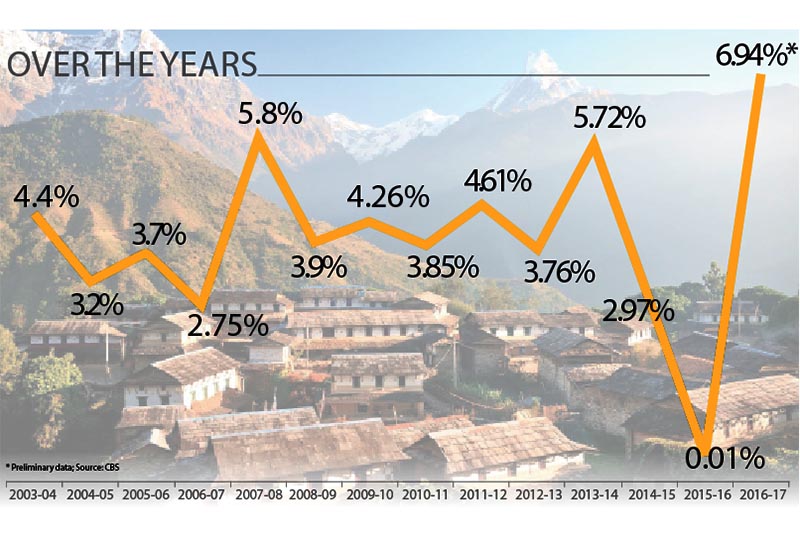Economy to grow by nearly 7pc this fiscal
Kathmandu, April 25
The country’s economy is expected to grow by 6.94 per cent in this fiscal due to improved agriculture production, rise in manufacturing output along with regular supply of electricity, low base of last fiscal, and a low number of strikes and bandhs, the Central Bureau of Statistics (CBS) said in its preliminary growth forecast for this fiscal today.
The size of the economy in nominal price will stand at Rs 2,599.23 billion in this fiscal compared to Rs 2,247.43 billion of last fiscal.
Compared to the base year price of 2000-01, this is the highest growth after the base year. Nepal is going to achieve high growth in this fiscal after the highest growth of 8.2 per cent that the country witnessed in fiscal 1993-94, the year from when CBS started calculating gross domestic product (GDP).
The CBS has prepared the preliminary growth projection based on the actual data of the first half of the fiscal year and estimated data of the remaining second half.
GDP growth of nearly seven per cent in the current fiscal is also due to the consecutive low base in the last two fiscal years due to the earthquake in 2014-15 followed by trade disruptions in 2015-16. Only 2.97 per cent and 0.01 per cent growth was achieved in 2014-15 and 2015-16, respectively.
In the current fiscal, growth of the agriculture sector and non-agriculture sector is expected to be at 5.29 per cent and 7.74 per cent, respectively. Contribution of the agriculture sector has declined from one-third of the GDP to 29.37 per cent of GDP along with the expansion of service and manufacturing sectors.
According to the CBS estimates, the total capital formation will be at 33.8 per cent of GDP as compared to 28.8 per cent of the last fiscal. The country’s national savings will be at just 10.25 per cent of the GDP, according to CBS. Likewise per capita income of Nepalis is expected to stand at $865 in this fiscal.
Unveiling the preliminary growth forecast, Chandra Kumar Ghimire, secretary of the National Planning Commission, said that the government now faces a challenge to maintain such high growth in the economy to achieve its target to graduate to a middle-income country by 2030.
Ghimire spoke about the multiplier impacts of the regular electricity supply and the low number of strikes in the production sector in this fiscal. The government’s policy initiative to provide access to finance to farmers, agriculture input supply and favourable monsoon are the key elements for high agriculture production.
“Rising government expenditure in recent times, post-earthquake reconstruction and forthcoming local election will also contribute in spurring growth and the country will be able to achieve nearly seven per cent growth,” he said.
The power sector is also one of the key components for this growth, along with the completion of projects generating around 100 megawatts of power in this fiscal. Completion of the 50-megawatt Upper Marsyangdi A and 25-megawatt Upper Madi projects among others will help raise the power sector growth to 12.97 per cent from a negative 7.4 per cent growth of last fiscal.






